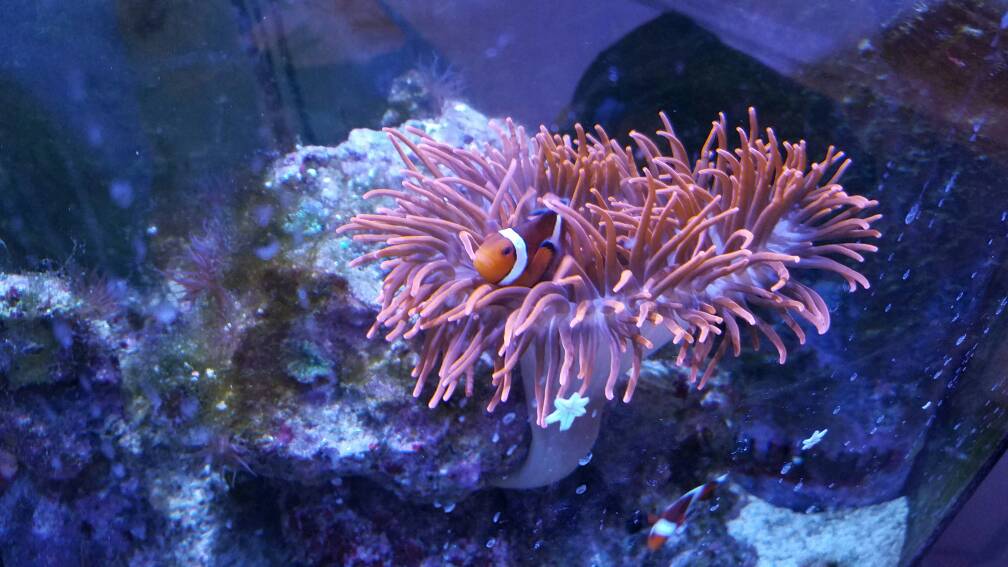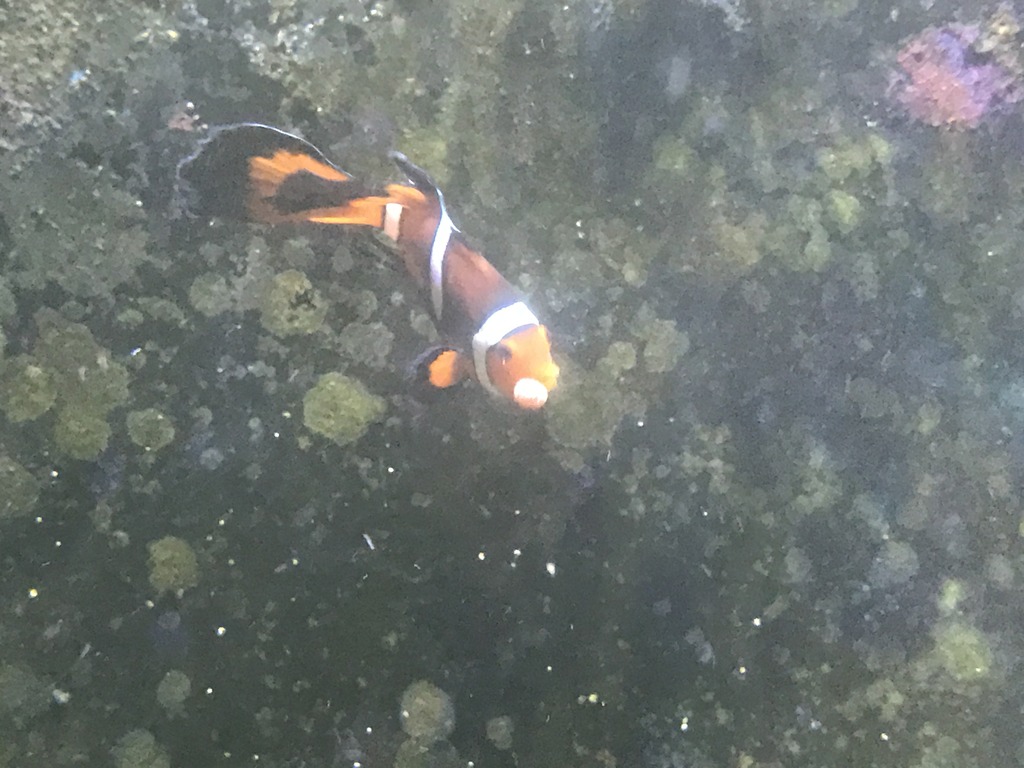melypr1985
totally addicted
View BadgesExcellence Award
Expert Contributor
Article Contributor
Moderator Emeritus
Picking Your Clownfish
You wouldn’t believe how many times I have been brought a betta bowl and asked “How many Nemos can I put in this?” No kidding, once a week at least! Now, these people are usually steered toward the bettas with no trouble at all especially after I start on the list of equipment needed to house just one Nemo. Needless to say, most of us know that keeping a clownfish has much more to it, than just a bowl of water. This article isn’t about what it takes to keep a clownfish, but more about what to expect from your clowns when picking them out, pairing up, and beyond.
Photo by: melypr1985
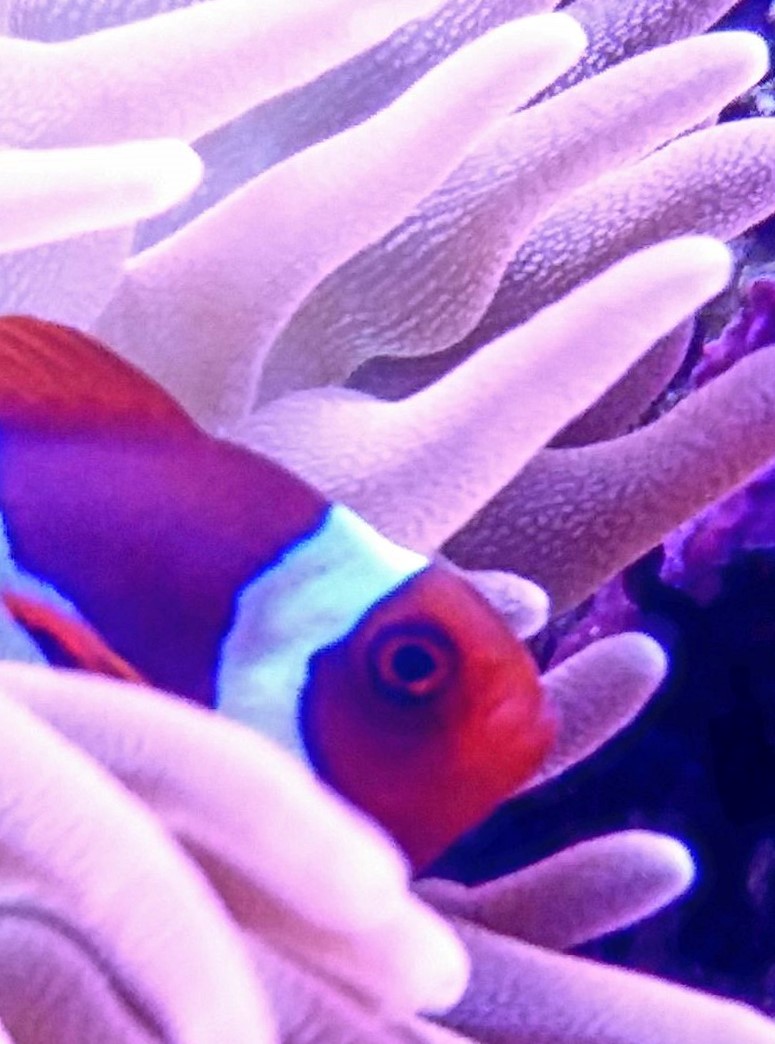
Let’s start at the beginning. Clownfish are what’s called Sequential Hermaphrodites which means that they are born without a sex (juveniles), change to males, then to females. They cannot change backwards, meaning if you have a female she can’t change to a male. This is very important when selecting the clownfish you want to keep. In most circumstances, it’s best to keep only a pair of clownfish in one tank. In the wild clownfish can live in a group based on hierarchy with a dominant female and male breeding pair and a group of juveniles. When/if the female dies, the dominant male becomes the female and the next in line changes to the male. In the home aquarium, it’s more difficult to achieve this since odds are you will purchase fish that aren’t juveniles anymore, but males and even a few males in transition to female. Space is also an issue with the “harem” tank. For you to be able to keep a group of clowns they must all be purchased as a group of juveniles and allowed to create their own hierarchy amongst themselves as they mature. In my opinion this means more than 5 clowns.
Photo by: Melev
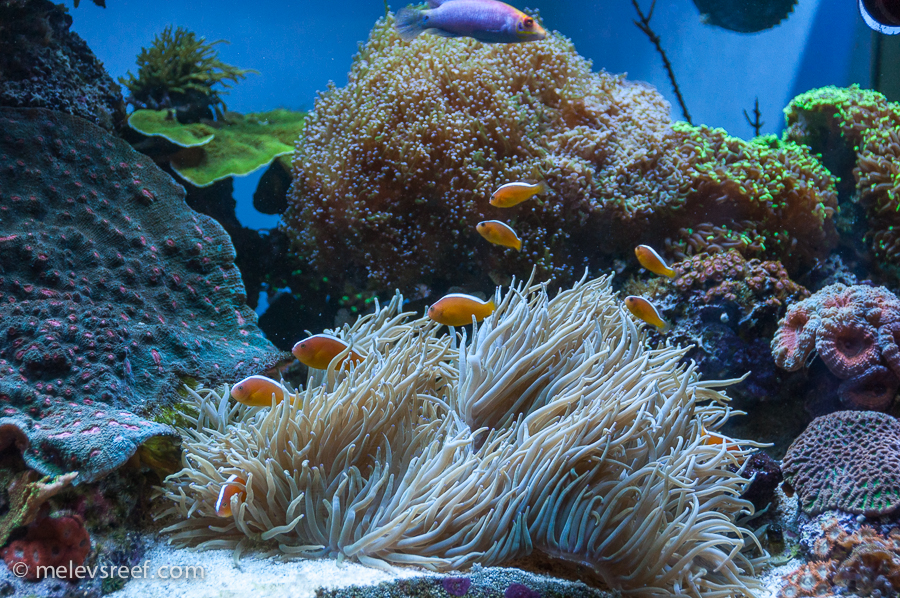
We will proceed on the assumption that you are a normal, everyday reefer that will purchase just two clownfish to keep as a pair. When you are out shopping at the stores or online you should be careful to note the size of the clownfish and how they are housed. If they are in a group in the tank, and they are all ½ inch – 3/4inch in size, then it’s a good bet they are all still juveniles. You shouldn’t see much aggression between then, just a lot of swimming together and making a ball in the corner or near a rock for safety. This would be a group that it is safe to pick any two fish you like best and attempt to pair them together. A clownfish that is alone, or even part of a small group needs to be watched closely for behavior. The largest or most aggressive should be considered a female already. If this is the one you want, then you should chose a clownfish that you know is a juvenile still- mostly judging by size and temperament. Choosing two clowns that are females, or have started the transition can results in two dead clowns, or one dead clown and one clown that is really beat up.
The next thing you need to consider before picking out your clownfish, is what type you want to get. There are six primary species of clownfish that you will find in the hobby today: Ocellaris, Percula, Clarkii, Skunk, Tomato and Maroon. Of those, you’ll find a huge – seemingly endless- variety of color patterns made from most of those species. The second most asked question I get is “Can I pair a marron clownfish with an Ocellaris clownfish?” or something to that effect. In general you want to stick with like species: Ocellaris with Ocellaris, Clarkii with Clarkii, Maroons with Maroons and so on. There are some exceptions like the Ocellaris seems to do just fine pairing up with the Percula. There have been some Ocellaris and Maroons paired up and bred even, but this particular pairing isn’t for the novice. As for all the different color and pattern variations of the Ocellaris and others, they can be mixed and matched as long as they are the same species. So a Snowflake can go with a Premium Gladiator and so on.
Photo by: melypr1985
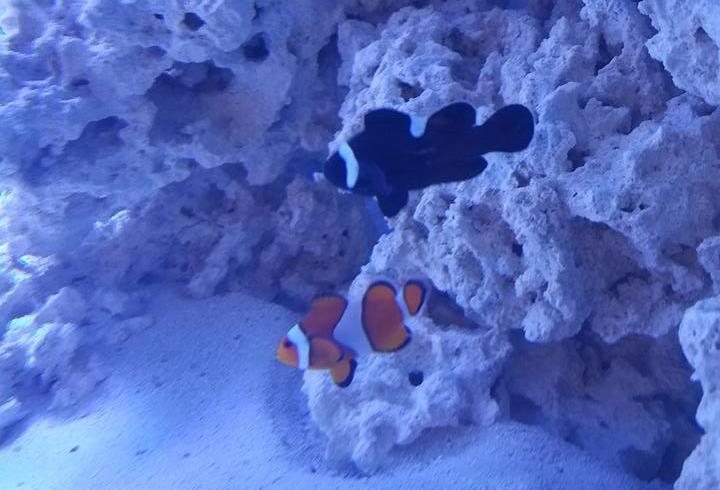
Clownfish are really cool because they have a symbiotic relationship with anemones. The fish is hosted by the anemone, a partnership that keeps the clown in the relative safety of the stinging anemone and the anemone feeds off of the clown’s poop. Clowns have also been known to grab food and feed the anemone that way. Clownfish have a very thick slime coat that protects them from both parasites and the sting of the anemone they are hosted by.
In my experience the Clarkii, Skunk, Tomato and Maroon are the most likely to host an anemone on it’s own. Now, this is strictly my opinion based on experience but I feel that Ocellaris and Percula have been bred so much and so often that I feel they have lost that innate need to host an anemone and instead will host the first thing they see as safe like your overflow. There are plenty of people who’s Percula and Ocellaris clowns are hosting an anemone right now, so that proves how inexact this hobby can be. Each fish in an individual and will do what comes naturally to them and makes them feel safe. If you want clownfish specifically so they will host an anemone, then I feel those fish will be your best bet. Having said that, I want to again say that each fish is an individual and no matter what you can force them to do what you want. Your clowns, no matter which you choose, may never host anything more interesting than your power head. On the other hand, your clowns may decide to host for you, but instead of those really nice anemones you paid so much for, they choose to host your GSP. Moral of that story? Don’t get clowns just because you want to watch them host a nem.
Photo by: JimSWreef
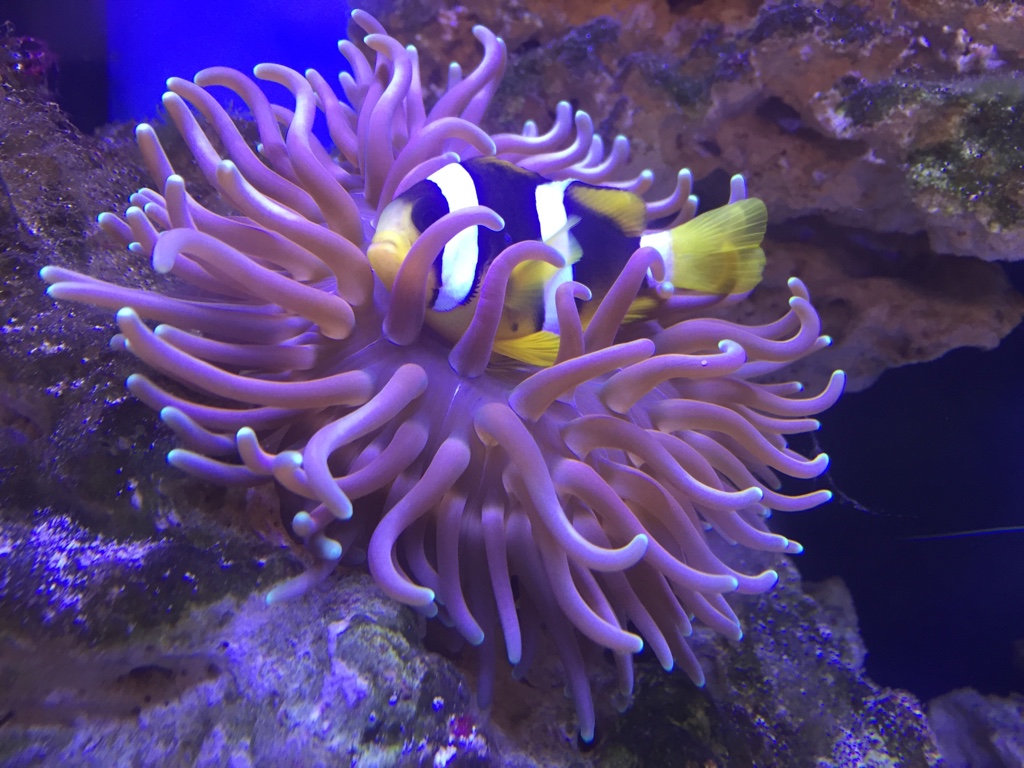
One more thing you should consider before choosing the type of clownfish you wish to purchase and that’s temperament. All clowns can be aggressive, especially the female and even more especially when they are spawning. There are levels of aggressiveness among the species of clowns that should be taken into account. Maroons, Tomatoes and clarkiis are at the top of this scale. They can get quite large, with maroons reaching 6 inches or more, and have been known to draw blood when going after the owner during maintenance. The Ocellaris, Percula and Skunk are the more docile of the group, but can still pack quite a punch. My female Ocellaris still attacks my hand anytime I get near her.
All of these are important when choosing which clowns to go with. The temperament, size, pairing, willingness to host will all play an important role in how your clownfish will fit into your tank’s dynamic. Choose carefully, because once you have a pair they can live for upwards of 20 years if taken care of properly. Adding a third clown to the mix will more than likely end badly so go with your two favorites from the first. Keep an eye out for more about clowns in the near future.
You wouldn’t believe how many times I have been brought a betta bowl and asked “How many Nemos can I put in this?” No kidding, once a week at least! Now, these people are usually steered toward the bettas with no trouble at all especially after I start on the list of equipment needed to house just one Nemo. Needless to say, most of us know that keeping a clownfish has much more to it, than just a bowl of water. This article isn’t about what it takes to keep a clownfish, but more about what to expect from your clowns when picking them out, pairing up, and beyond.
Photo by: melypr1985
Let’s start at the beginning. Clownfish are what’s called Sequential Hermaphrodites which means that they are born without a sex (juveniles), change to males, then to females. They cannot change backwards, meaning if you have a female she can’t change to a male. This is very important when selecting the clownfish you want to keep. In most circumstances, it’s best to keep only a pair of clownfish in one tank. In the wild clownfish can live in a group based on hierarchy with a dominant female and male breeding pair and a group of juveniles. When/if the female dies, the dominant male becomes the female and the next in line changes to the male. In the home aquarium, it’s more difficult to achieve this since odds are you will purchase fish that aren’t juveniles anymore, but males and even a few males in transition to female. Space is also an issue with the “harem” tank. For you to be able to keep a group of clowns they must all be purchased as a group of juveniles and allowed to create their own hierarchy amongst themselves as they mature. In my opinion this means more than 5 clowns.
Photo by: Melev
We will proceed on the assumption that you are a normal, everyday reefer that will purchase just two clownfish to keep as a pair. When you are out shopping at the stores or online you should be careful to note the size of the clownfish and how they are housed. If they are in a group in the tank, and they are all ½ inch – 3/4inch in size, then it’s a good bet they are all still juveniles. You shouldn’t see much aggression between then, just a lot of swimming together and making a ball in the corner or near a rock for safety. This would be a group that it is safe to pick any two fish you like best and attempt to pair them together. A clownfish that is alone, or even part of a small group needs to be watched closely for behavior. The largest or most aggressive should be considered a female already. If this is the one you want, then you should chose a clownfish that you know is a juvenile still- mostly judging by size and temperament. Choosing two clowns that are females, or have started the transition can results in two dead clowns, or one dead clown and one clown that is really beat up.
The next thing you need to consider before picking out your clownfish, is what type you want to get. There are six primary species of clownfish that you will find in the hobby today: Ocellaris, Percula, Clarkii, Skunk, Tomato and Maroon. Of those, you’ll find a huge – seemingly endless- variety of color patterns made from most of those species. The second most asked question I get is “Can I pair a marron clownfish with an Ocellaris clownfish?” or something to that effect. In general you want to stick with like species: Ocellaris with Ocellaris, Clarkii with Clarkii, Maroons with Maroons and so on. There are some exceptions like the Ocellaris seems to do just fine pairing up with the Percula. There have been some Ocellaris and Maroons paired up and bred even, but this particular pairing isn’t for the novice. As for all the different color and pattern variations of the Ocellaris and others, they can be mixed and matched as long as they are the same species. So a Snowflake can go with a Premium Gladiator and so on.
Photo by: melypr1985
Clownfish are really cool because they have a symbiotic relationship with anemones. The fish is hosted by the anemone, a partnership that keeps the clown in the relative safety of the stinging anemone and the anemone feeds off of the clown’s poop. Clowns have also been known to grab food and feed the anemone that way. Clownfish have a very thick slime coat that protects them from both parasites and the sting of the anemone they are hosted by.
In my experience the Clarkii, Skunk, Tomato and Maroon are the most likely to host an anemone on it’s own. Now, this is strictly my opinion based on experience but I feel that Ocellaris and Percula have been bred so much and so often that I feel they have lost that innate need to host an anemone and instead will host the first thing they see as safe like your overflow. There are plenty of people who’s Percula and Ocellaris clowns are hosting an anemone right now, so that proves how inexact this hobby can be. Each fish in an individual and will do what comes naturally to them and makes them feel safe. If you want clownfish specifically so they will host an anemone, then I feel those fish will be your best bet. Having said that, I want to again say that each fish is an individual and no matter what you can force them to do what you want. Your clowns, no matter which you choose, may never host anything more interesting than your power head. On the other hand, your clowns may decide to host for you, but instead of those really nice anemones you paid so much for, they choose to host your GSP. Moral of that story? Don’t get clowns just because you want to watch them host a nem.
Photo by: JimSWreef
One more thing you should consider before choosing the type of clownfish you wish to purchase and that’s temperament. All clowns can be aggressive, especially the female and even more especially when they are spawning. There are levels of aggressiveness among the species of clowns that should be taken into account. Maroons, Tomatoes and clarkiis are at the top of this scale. They can get quite large, with maroons reaching 6 inches or more, and have been known to draw blood when going after the owner during maintenance. The Ocellaris, Percula and Skunk are the more docile of the group, but can still pack quite a punch. My female Ocellaris still attacks my hand anytime I get near her.
All of these are important when choosing which clowns to go with. The temperament, size, pairing, willingness to host will all play an important role in how your clownfish will fit into your tank’s dynamic. Choose carefully, because once you have a pair they can live for upwards of 20 years if taken care of properly. Adding a third clown to the mix will more than likely end badly so go with your two favorites from the first. Keep an eye out for more about clowns in the near future.
Last edited by a moderator:








